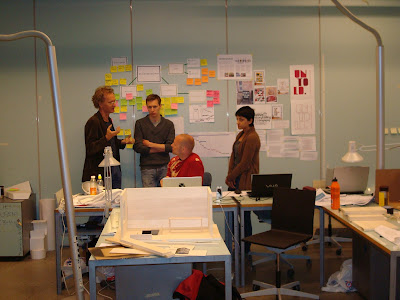Euro Diaries - Oslo
The last Scandinavian destination on my study tour was Oslo. For this leg of the trip I flew SAS. I had checked in electronically with a Nokia Lumia 800 phone that Steve Heck, the CIO of Microsoft Canada, had lent me to try its Windowsphone 7.5 OS. My boarding pass was downloaded as a PDF to the phone and included a QR code. I had to check in my suitcase and was directed to the SAS self-service kiosks to get the tags to be affixed to the luggage. When I was prompted to put in my boarding pass for a scan, I put in the Lumia 800 with the e-pass open. That didn't work. After several attempts at enlarging and positioning the QR code and not having success, an employee of SAS came to help. He took over the Lumia and tried everything I had already done, which told me that the use of e-boarding passes is normal and that Customer Service reps behave the same everywhere. We finally used the flight booking reference to print a paper boarding pass, which then allowed me to get the luggage tags.
I am not sure what the cause of the problem with the Lumia e-pass. Nokia phones are very widely used in Europe, particularly in Scandinavian countries. I suspect it has to do with the PDF rendering of the QR code by Windowsphone within the e-pass. More testing required.
My main destination in Oslo was AHO, the Oslo Architecture & Design School. It is in an interesting building. It used to house the maintenance workshops of Oslo's electric utility. AHO re-arranged the building and added a new wing.
The building has three levels, the second of which is designed as a green roof and patio with "green" stairs leading to the cafeteria on the ground floor:
On our arrival day at AHO critiques/defenses of graduation thesis was in progress. I visited a few of the Architecture Institute graduation projects and learned a few facts: the jury is fully external to AHO and usually includes 1-2 (sometimes all 3) from other Scandinavian countries (Denmark, Sweden). Jury members receive the full thesis text a couple of weeks before defense, prepare written comments on it and then each jury member presents his/her opinion to the audience attending the defense. The first such presentation was so detailed, I thought it was the student presenting!
I also attended some of the sustainable design graduation projects. They were taking place in a large studio, where each of the defending projects had to be displayed on a dedicated wall space. Summary color prints where available as take away as well as a few copies of the published thesis in a paperback booklet format that I found really nice to handle and to read. One project I found particularly interesting was a study of a small island called Utsira and the planning for developing the island to meet ecological objectives by 2022. The analysis and planning addressed energy, buildings, food, culture, transportation and communications in an integrated fashion.
I took one afternoon to meet with local Sandboxer Brock LeMieux at his "project" site. The site turned out to be an old pub being converted by Brock and his partner into a co-working space.While conversion work was still in progress, the energy of the place was palpable. We decided to chat outside to take advantage of the sunny weather. Chairs, table and pots of coffee were simply moved to a minimalist deck in front of the place, where we then had a wonderful conversation on models for co-working places and incubation, the future of higher education and the role of design and design thinking. I enjoyed the discussion thoroughly. It reminded me much of our Overlap discussions.
On my last afternoon in Oslo I was taken on a tour of the building by Prof. Hakan Edeholt. During the tour I finally had opportunity to meet with students doing interdisciplinary projects in their studios.
The first group (Bai Daniel Ogaard, Kristian Aarseth, Morten Evensmo and Hanne Nilsen), was working on a Laparoscopic Simulator in virtual reality in collaboration with a corporation, SimSurgery. Laparoscopic surgery is a minimally invasive surgery technique putting high demands of coordination and precision on the surgeons. The simulator they designed is compact, plug-and-play, and an affordable desktop simulator resolving a number of the disadvantages of previous simulators.
The project was part of an initiative called Protohype AHO 2012, which aimed at hyping prototypes of future technologies. It reminded me strongly of the SFI program's tangible futures activities.
The second group of students researched the needs and experience of old people in "assisted living" facilities and proposed solutions for improvements through technology, design and empowerment. After a PowerPoint presentation provided to me on the spot without prior notice I was also shown videos that the students produced to pitch their results and design proposals in an effective way.
An interesting aspect of AHO design program is that groups of students haves to organize themselves as independent commercial design cabinets and develop a pitch of their skills and interests. The companies participating in the program also develop a short presentation of their strengths and research interests. After attending each other pitches each side (student design cabinets and companies) lists the top three preferred "partner" they would like to work with. The program administration then tries to match the parties. In the last round no one got assigned a partner lower in preference than their second choice. IP rights of the then carried out research and developments are owned by the company but students get employment or long-term contracts opportunities through this system.
Labels: agile, AHO, architecture, commercialization, innovation, Norway, Oslo








